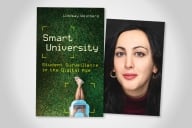You have /5 articles left.
Sign up for a free account or log in.
If you are a low-income prospective college student hoping a degree will help you move up in the world, you probably should not attend a moderately selective four-year research institution. The cards are stacked against you.
That’s the sobering bottom line of Paying for the Party: How College Maintains Inequality (Harvard University Press), a new book based on five years of interview research by Elizabeth A. Armstrong, an associate professor of sociology and organizational studies at the University of Michigan, and Laura T. Hamilton, an assistant professor of sociology at the University of California at Merced.
It’s not entirely the colleges’ fault, Hamilton says. Declining state and federal support and rising tuition have made it critical to recruit students who can pay more (and who continue to donate after they leave). But the out-of-state and affluent students attending these colleges are not in it for the academics – those students are going to the Harvards, Michigans and Berkeleys of the world.
The students who end up at Midwestern University – a pseudonym for the flagship institution where Armstrong and Hamilton follow a group of women through their college careers, from the dorm floor to a year post-graduation – are socially minded. Thus, to lure and keep those students, institutions have come to structure their academic and social frameworks in a way that accommodates that population.
The result of this “party pathway” is more than just a substandard education for those students, whose significant family resources and connections -- which set them up for jobs after graduation, regardless of credentials -- allow them to take easy majors and spend as much time if not more drinking as they do studying. It also deters those on the “mobility pathway,” as those low-income students seeking entry into the middle class are both poorly supported and distracted by the party framework. As a result, many of these students struggle to succeed -- meandering through college for six years or more -- or drop out altogether.
Of the less privileged students Armstrong and Hamilton tracked, those who transferred to a regional university or community college were actually more successful than those who tried to stick it out at MU. Still, they were less successful career-wise than their more privileged peers, and not one of the six working-class students on Armstrong and Hamilton's floor graduated within five years.
“There’s a mismatch between what they need and what the university can offer them, and that’s where class stratification happens,” Hamilton said in an interview. “The university is set up to serve a group of very affluent students.”
The co-author of Academically Adrift, Richard Arum, whose research famously showed that a striking number of students learn little to nothing of intellectual significance in college, said in an interview that the book powerfully demonstrates that that lack of learning is not just attributable to student laziness. “This current work shows how students can – from their perspective – come to understand and interpret the life of being a student, the life of being in college, as having very little to do with academic engagement,” Arum said. “The institution itself has basically built this into the structure of higher education today.”
This setup was prompted by external forces, but the universities’ response -- while “inadvertent, not intentional,” Hamilton says -- did have gendered and class consequences.
“Most administrators are committed to educational quality, higher academic standards, serving first-generation and minority students. Their goals are very much in line with a mobility pathway,” Hamilton said. “But the reality that they’re facing – I think a lot of administrators know or understand some of these consequences, but solvency issues are pretty intense.”
Armstrong and Hamilton include myriad anecdotes to detail how MU accommodated the party pathway and played to the desires of its students. In one instance, a math exam was rescheduled because it interfered with sorority rush. MU stood by while fraternities dominated university-sanctioned social events or even kicked them off campus to make room for their own events. (Only 17 percent of MU's students go Greek, but they dominate the social scene on- and off-campus. The time commitment required to participate in Greek life makes challenging oneself academically or holding down a job impossible.)
The party scene, dominated by fraternities and sororities that sit in the heart of campus, perpetuated social hierarchies based on appearance, race, wealth and men's perceptions of women; heavy alcohol use; and a culture of hooking up. Armstrong and Hamilton describe how students sitting in an academic building could look out the window and see fraternity members playing beer pong, or young women lined up in the cold waiting to get into parties.
"I hooked up with Alex twice," one woman said in an anecdote emblematic of the sexual dynamics within Greek life at MU. "I mean I just don't hear anything from him anymore. I even went over there and he did not say hi to me. So, but it's fine 'cause I've learned my lesson."
In residence life, MU (like its peer institutions) allows students to self-select into dorms. Everyone is required to live on campus freshman year, with a few exemptions including married, older and part-time students. Inevitably, the affluent students with family connections and social know-how dominate the dorms with the party reputations, leaving the less privileged students who just wound up there extremely isolated and prone to falling through the cracks.
Academically, MU sponsors many easy majors (characterized by high grade-point averages, low demonstration of learning, and areas of study where appearance and social abilities are more essential than actual skill – for example, tourism, fashion merchandising and sports broadcasting) that draw socially oriented students, and are not found at more elite institutions. Students who are not socially oriented, but who fail entry exams or struggle with the courseload of more difficult majors, have these options as backup, but don't have the networks to succeed once they graduate. And less privileged students sometimes suffered at the hand of academic advisers whose advice seemed more suited for students on the party pathway. (For example, students changing to easy majors because they saw affluent peers succeeding there, or who didn't understand the long-term consequences of putting off general courses in favor of others that didn't transfer majors, did not receive advice to the contrary.)
"I was [at MU] for two years and I was flipping through so many majors 'cause I didn't know what I wanted to do," said one woman who ended up transferring.
The authors make a number of suggestions as to what universities could do to turn things around -- which they acknowledge are unlikely to happen, given the worsening fiscal climate. Among them: resist the temptation to recruit more out-of-state and international students, who create demand for the party pathway and take spots from in-state students of modest means, and provide affordable tuition and accessible and generous financial aid; eliminate or seriously crack down on Greek life, which has deep institutional ties and dominates the social scene in exclusive and detrimental fashion, but whose members tend to donate heavily to their alma maters; get rid of the easy party pathway majors; scale back athletics; build up the mobility pathway with better advising and necessary, well-taught and transferable courses; and broaden access to the third pathway – the “professional” one – by banning legacy admissions and making entry into selective programs more flexible and widely available.
But until states invest more in higher education, Hamilton said, universities will likely be hard-pressed to divert their focus from the students who bring in the most tuition dollars and alumni donations.
“One of our biggest concerns is that somebody would read the book and say, ‘Look, this is evidence that higher ed in the U.S. is horrible and we should just stop funding it,’ ” Hamilton said. “The message we wanted people to walk away with is, ‘Look, this is the consequence of cutting higher ed funds. This is what you get – public universities start to look more and more like private universities and they have to serve the highest bidders.’ ”
But if the funding isn't reversed and universities don’t change their ways, Hamilton argues, they'll continue to enroll more upper and upper-middle class students from out of state and abroad, and the less privileged in-state students who can’t afford it will have to pursue other, more affordable options, such as online education.
Professors can help, too, the authors suggest, but to do so would require a shift in priorities. Paying more attention to weak students who don’t help with research and pairing the strongest faculty members with the least prepared students would strengthen the mobility pathway, Hamilton and Armstrong say. And scheduling more Friday classes would deter students from partying on Thursday nights.
The vastly different outcomes for the students followed in the book serve as a “wake-up call” for colleges, said Alexander C. McCormick, an associate professor of higher education at Indiana University at Bloomington and director of the National Survey of Student Engagement.
“As colleges and universities have – to their credit – diversified the student population that they serve, the need to provide support services and guidance for students from, for example, non-college-educated backgrounds, have increased. And I’m not sure that the services have really kept up with that pace,” McCormick said, attributing that discrepancy at least in part to the transformation of higher education from a public social good to an individual benefit. “There’s need for more intrusive mechanisms, early identification of students who may not be doing well, and intervention to sort of help them find the right way through class.”
Prospective college students who are working class and not wealthy, whose parents do not have extensive social connections -- those on the mobility pathway -- should be wary of attending a four-year residential university like Midwestern, Hamilton said. Rather than basing their decision on prestige, which is often encouraged, they should consider whether a university will meet their specific needs. That means looking at retention rates for minority and first-generation students, whether student services are large and accessible (universities often have small creaming programs that serve low-income students well, but only a very small number of them), which academic programs and pathways are well-resourced, and the visibility of Greek life and the party scene.
Armstrong and Hamilton close their book by following up on Alana, a mobility pathway student whose social isolation in one of MU’s many party dorms nearly caused her to leave the university. While some of Alana’s peers who succumbed to the party pathway and/or couldn’t keep up academically or financially dropped out, Alana managed to eventually adjust to college with the help of her father, who paid for an apartment (a luxury other students from disadvantaged backgrounds did not have).
As the authors describe, despite Alana’s trouble acclimating and the fact that her degree did not “shift her toward a middle-class life” -- she was working minimum-wage jobs that did not require a degree after college – she was “really glad” she went to MU because it introduced her to “two central loves of her life – nature and a man who was similarly devoted to the outdoors.”
The authors use this anecdote not to justify the direction MU has taken, but to make a case for its improvement, so that students can both grow into themselves and experience life outside their hometowns, as Alana did, and gain a worthwhile education that puts them on an upwardly mobile economic trajectory.








